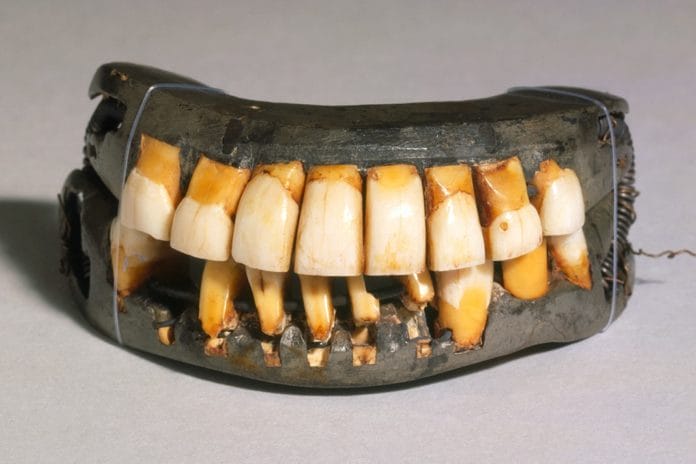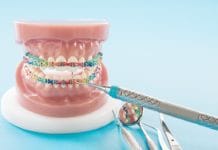Urban legends are types of modern folklore or fictional stories presented as true and used for entertainment or to serve as cautionary tales. Urban legends were first published in 1968 and are typically complete stories with plots and characters that are “rooted in popular culture” and display elements of “fear, humor, mystery or horror”.1 The urban legends of dentistry can be just as mysterious and fearful as those most commonly found in American culture.
George Washington’s Denture
One of the most familiar urban legends of dentistry is that George Washington’s denture was made from wood. George Washington had suffered from severe dental problems since his twenties. It is presumed the Virginia-born president initiated teeth transplant surgery, completed by his personal dentist, Jean Pierre LeMayeur, using the teeth of Washington’s slaves. However, the surgery was unsuccessful. Having only one remaining tooth left, Washington asked dentist John Greenwood to fabricate his first set of dentures which were made of ivory, brass, and gold. This same set of dentures was worn by George Washington when he gave his first inaugural speech.
The library of Mount Vernon concluded the rumor of George Washington’s dentures being fabricated from wood was due to staining of the ivory, thus giving it a “grained, wood appearance”.2 Aside from the wood-like appearance, the dentures caused jaw discomfort and the first president’s lip to bulge, giving him a disfigured and dour appearance. This look can be seen in his famous Gilbert Stuart portrait of 1796, which is commonly displayed on the one dollar bill. The famous set of dentures, gifted to John Greenwood by George Washington, can be seen at the Donald Reynolds Museum and Education Center in Mount Vernon, Virginia.
The Tooth Fairy
Another well-known urban legend is the tooth fairy, who visits a child at night to retrieve the baby tooth the child has lost and has placed under his or her pillow in exchange for a monetary gift. The tooth fairy legend was first printed in an eight-page playlet for children written by Esther Watkins Arnold in 1927. There are many other legends involving the loss of baby teeth which include throwing the tooth in the sunlight, throwing the tooth in fire, and placing the tooth in a mouse hole, so an adult tooth erupts as strong as a rat’s tooth. The tooth mouse legend is most predominantly told in Mexico, Russia, and European countries. However, the tooth fairy legend is believed to have arisen in order to initiate a positive feeling from the child afraid of losing a tooth.
Tooth Restorations Emitting Music and Morse Code
Then, there is the urban legend of Lucille Ball’s fillings emitting music and Morse code that was first revealed by Lucille Ball on “The Dick Cavette Show” in 1974. According to this legend, in 1942 Lucille Ball was driving home from filming when she heard music, but not from the car radio; the music was coming from her mouth. Lucille Ball also stated that one week later, her fillings picked up Morse code. The legend goes on to describe how Miss Ball alerted authorities and, as a result, the FBI busted a Japanese gardener operating a spy ring from his garden shed. Over the years, the legend had never been proved or disproved.
In 2003, Mythbusters, a popular television program that tests hypothesis and legends, such as the one involving Lucille Ball’s fillings, set forth to verify the legend’s credibility, but the test results were inconclusive. Mythbusters did formulate that a signal may have been picked up by Lucille Ball’s filling due to a “Galvanic cell reaction.”3 This reaction occurs when two different metals are in contact with a salt solution acting as a buffer, which, in this case, was saliva.
Teeth Dissolving in Coca-Cola
One urban legend involving Coca-Cola has circulated for years. The legend testifies a tooth placed overnight in a glass of Coca-Cola will totally dissolve. Although believed by many, the credibility of this legend has been disproved. The acidic reaction of the Coca-Cola solution is, in fact, not as strong as natural stomach acid. The pH level of stomach acid is 1.35 to 3.5 and aids in digestion and protects against microbial organisms. The pH level of Coca-Cola is measured at 2.34 to 2.96, significantly less than stomach acid. Tooth erosion is active at a pH range of 2 to 4, and demineralization occurs as pH levels drop below 5.5. Therefore, Coca-Cola can contribute to tooth erosion and demineralization, but the reaction occurs over time, not overnight, and is accompanied by poor oral hygiene.
Dental Death
Last, an urban legend propagated in dental school is the legend of “dental death.”4 There are actually two versions of the dental death legend. Although there is no evidence of truth to these stories, they are both horrifying to any dental clinician.
The first version involves a dentist treating a patient who dies in the chair late in the day. So the dentist moves the body to the first-floor restroom and returns to his clinic to tidy up and calm himself before leaving for home. After a few minutes, the door to his clinic opens, and the dead man appears, having been revived by the impact of being dragged down the stairs, which supposedly acted as CPR and thus resurrecting the patient.
The second version is a dentist treating two patients under anesthesia in separate rooms and, as the dentist is attending to one patient who is having a negative reaction to the anesthesia, the second patient passes in the chair. This tale has all the pieces of an urban legend: horror, fiction, fear, character, and plot.
Urban legends are told throughout our culture, and they often elicit fear, mystery, or comic feelings in those exposed to the story. The month of October, establishing its name from the eighth month, “octo” and the Old English name “Winterfylleth,” referring to Winter Full Moon is best known for its celebration of Halloween.5 Therefore, tooth be told, this seems to be the best season for the telling of urban legends in dentistry.
Before you leave, check out the Today’s RDH self-study CE courses. All courses are peer-reviewed and non-sponsored to focus solely on high-quality education. Click here now.
Listen to the Today’s RDH Dental Hygiene Podcast Below:
SEE ALSO: 10 Pet Peeves of Dental Hygienists (And 5 Patient Pet Peeves)
DON’T MISS: 4 Things Dental Hygienists Don’t Like to Hear
References
- Definition of Urban legends. Retrieved from: https://en.wikipedia.org/wiki/Urban.legend
- William M. Etter, PhD, Irvine Valley College. Wood Teeth Myth. Retrieved from: https://www.mountvernon.org/library/digitalhistory/digital-encyclopedia/article/wooden-teeth-myth/
- Wikipedia (2003). Mythbusters: Radio Tooth Fillings. 2003 season, Episode 4. Retrieved from: https://en.wikipedia.org/wiki/MythBusters_(2003_season)
- Jan Harold Bruvard (2011). Too Good To Be True: The Colossal Book of Urban Legends. WW Norton & Company, Feb. 7, 2011.
- Andrew (2009). The Meaning of October. Oct. 1, 2009. Retrieved from: www.Inpurespirit.com/63/the-meaning-of-October/
- Evan Andrews. Did George Washington Have Wooden Teeth? Retrieved from: https://www.history.com/news/did-george-washington-have-wooden-teeth
- Michael Hingston (2014). Don’t tell kids the real history of the tooth fairy. Feb. 9, 2014. Retrieved from: https://salon.com/2014/02/09/dont_tell_the_kids_the_real_history_of_the_tooth_fairy/













